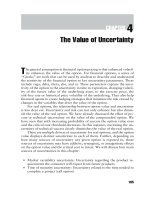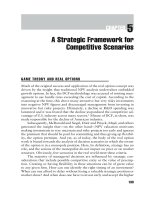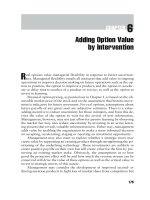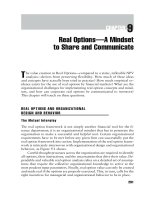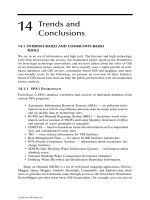Lecture Project management in practice - Chapter 14: Project risk management
Bạn đang xem bản rút gọn của tài liệu. Xem và tải ngay bản đầy đủ của tài liệu tại đây (901.95 KB, 22 trang )
CHAPTER 14
Project Risk Management
Copyright © 2013 McGraw-Hill Education (Australia) Pty Ltd
Pearson, Larson, Gray, Project Management in Practice, 1e
14-1
Risk Event Graph
Copyright © 2013 McGraw-Hill Education (Australia) Pty Ltd
Pearson, Larson, Gray, Project Management in Practice, 1e
14-2
Risk Management Process
Copyright © 2013 McGraw-Hill Education (Australia) Pty Ltd
Pearson, Larson, Gray, Project Management in Practice, 1e
14-3
Risk Management
Process (cont.)
• Step 1: Establishing the risk context
• Step 2: Risk identification
• Step 3: Risk analysis
• Step 4: Risk evaluation
• Step 5: Risk treatment
• Step 6: Contingency planning
Copyright © 2013 McGraw-Hill Education (Australia) Pty Ltd
Pearson, Larson, Gray, Project Management in Practice, 1e
14-4
Step 1: Establishing the
Risk Context
• What is the organisation’s context
for risk?
• How does this affect the project
environment?
• How are ‘individual’ risk tolerances
levelled?
• Do you use the ‘As Low As
Reasonably Possible’ (ALARP)
approach?
Copyright © 2013 McGraw-Hill Education (Australia) Pty Ltd
Pearson, Larson, Gray, Project Management in Practice, 1e
14-5
Step 2: Risk Identification
• WBS
• RBS
• Risk Profiles
• Lessons learned
• Delphi method
• SWOT
• Others…
Copyright © 2013 McGraw-Hill Education (Australia) Pty Ltd
Pearson, Larson, Gray, Project Management in Practice, 1e
14-6
Step 2: Risk Identification (cont.)
The Risk Breakdown Structure (RBS)
Copyright © 2013 McGraw-Hill Education (Australia) Pty Ltd
Pearson, Larson, Gray, Project Management in Practice, 1e
14-7
Step3: Risk Analysis
• Probability refers to the
probability of the event. (This is
otherwise known as the likelihood
of the risk occurring.)
• Impact refers to the impact of the
event. (This is otherwise known
as the consequence of the risk if
the event occurs.)
Copyright © 2013 McGraw-Hill Education (Australia) Pty Ltd
Pearson, Larson, Gray, Project Management in Practice, 1e
14-8
Step 3: Risk Analysis
Simple ‘inherent’ risk analysis
Copyright © 2013 McGraw-Hill Education (Australia) Pty Ltd
Pearson, Larson, Gray, Project Management in Practice, 1e
14-9
Step 3: Risk Analysis (cont.)
mpact considered over multiple criteria
Copyright © 2013 McGraw-Hill Education (Australia) Pty Ltd
Pearson, Larson, Gray, Project Management in Practice, 1e
14-10
Step 3: Risk Analysis (cont.)
Decision tree analysis
Copyright © 2013 McGraw-Hill Education (Australia) Pty Ltd
Pearson, Larson, Gray, Project Management in Practice, 1e
14-11
Step 4: Risk Evaluation
• The purpose of risk evaluation is to assist
in making decisions, based on the
outcomes of the risk analysis, about which
risks need treatment and the priority for
treatment implementation.
• Risk evaluation involves comparing the
level of risk found during the analysis
process with risk criteria established when
the context was considered.
• Based on this comparison, the need for
treatment can be considered. (AS/NZS/ISO
31000:2009)
Copyright © 2013 McGraw-Hill Education (Australia) Pty Ltd
Pearson, Larson, Gray, Project Management in Practice, 1e
14-12
Step 5: Risk Treatment
for Threat Risks
• Mitigating risk
• Avoiding risk
• Transferring risk
• Accepting (retaining) risk
Copyright © 2013 McGraw-Hill Education (Australia) Pty Ltd
Pearson, Larson, Gray, Project Management in Practice, 1e
14-13
Step 5: Risk Treatment (cont.)
Mitigation and residual risk assessment
Copyright © 2013 McGraw-Hill Education (Australia) Pty Ltd
Pearson, Larson, Gray, Project Management in Practice, 1e
14-14
Step 5: Risk Treatment
for Opportunity Risks
• Exploit
• Share
• Enhance
• Accept
Copyright © 2013 McGraw-Hill Education (Australia) Pty Ltd
Pearson, Larson, Gray, Project Management in Practice, 1e
14-15
Step 6: Contingency
Planning
contingency plan is an
alternative plan that will be used
if a possible foreseen risk event
becomes a reality (an issue).
Copyright © 2013 McGraw-Hill Education (Australia) Pty Ltd
Pearson, Larson, Gray, Project Management in Practice, 1e
14-16
Step 6: Contingency
Planning (cont.)
Risk contingency plan
Copyright © 2013 McGraw-Hill Education (Australia) Pty Ltd
Pearson, Larson, Gray, Project Management in Practice, 1e
14-17
Step 6: Contingency
Planning (cont.)
Common methods for handling risk
• Technical risks
• Schedule risks
• Cost risks
• Funding risks
Copyright © 2013 McGraw-Hill Education (Australia) Pty Ltd
Pearson, Larson, Gray, Project Management in Practice, 1e
14-18
Contingency Funds and
Risk
• Budget reserves
• Management reserves
• Time buffers
ow are risk contingencies
managed in your organisations?
Copyright © 2013 McGraw-Hill Education (Australia) Pty Ltd
Pearson, Larson, Gray, Project Management in Practice, 1e
14-19
Risk Management Plan
• Risk context
• Risk methodology
• Risk roles and responsibilities
• Risk escalation process
• Risk reporting
• Risk audits and health checks
• Lessons learned
Copyright © 2013 McGraw-Hill Education (Australia) Pty Ltd
Pearson, Larson, Gray, Project Management in Practice, 1e
14-20
Risk Monitoring and Review
Copyright © 2013 McGraw-Hill Education (Australia) Pty Ltd
Pearson, Larson, Gray, Project Management in Practice, 1e
14-21
Key Terms
•
•
•
•
•
•
•
•
•
•
•
•
•
5 Whys
ALARP
AS/NZS/ISO 31000:2009
assumptions
constraints
contingency plan
contingency planning
decision trees
decision tree analysis
Delphi Method
Failure Mode and Effects
Analysis (FMEA)
impact (consequence)
mitigation strategy (risk
response)
Monte Carlo technique
opportunity risk
PERT
PERT simulation
probability (likelihood)
risk analysis
risk breakdown structure (RBS)
risk context
risk evaluation
risk identification
Risk Management Plan
risk monitoring and review
risk profile
Risk Register
risk severity matrix
root cause analysis
threat risk
Copyright © 2013 McGraw-Hill Education (Australia) Pty Ltd
Pearson, Larson, Gray, Project Management in Practice, 1e
14-22



